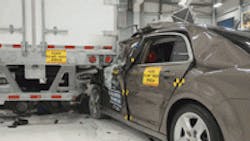The Insurance Institute for Highway Safety has released the results of a months-long series of crash tests that have highlighted an area in current trailer underride regulations that the institute wants strengthened.
The Insurance Institute for Highway Safety completed the tests in January and has now released the results. IIHS is petitioning NHTSA for tougher performance standards. Those requirements are found in Federal Motor Vehicle Safety Standard 223 and 224.
The IIHS tests included extreme offset crashes in which the car strikes the end of the underride guard’s horizontal bar. With no vertical member to help protect the vehicle during these crashes, the guard has only the ends of the crossbar to slow the vehicle as it slams into the rear of the trailer at 35 mph.
The tests involved underride guards of eight major trailer manufacturers. Three rounds of tests were performed, each set of tests more difficult than the previous set. The first set of tests involved crashing the car into the center of the underride guard. A second set of tests involved a 50% offset.
All eight manufacturers passed the first round of tests, and all but one passed the second set. The failures occurred during the third round of testing. All but one of the offset tests ended with the ends of the crossbar giving way and the automobile underriding the trailer.
In general, today’s underride guards are meeting or exceeding the performance requirements of the regulations.
“Modern semitrailers for the most part do a good job of keeping passenger vehicles from sliding underneath them, greatly increasing the chances of surviving a crash into the back of a large truck,” IIHS said in announcing the results of the research. “But in crashes involving only a small portion of the truck’s rear, most trailers fail to prevent potentially deadly underride.”
Based on earlier research, the Institute petitioned NHTSA in 2011 to raise underride standards. The Institute also asked the agency to expand the regulations to cover other types of large trucks, such as dump trucks.
A full report on IIHS tests will appear in the April issue of Trailer/Body Builders.
About the Author
Bruce Sauer
Editor
Bruce Sauer has been writing about the truck trailer, truck body and truck equipment industries since joining Trailer/Body Builders as an associate editor in 1974. During his career at Trailer/Body Builders, he has served as the magazine's managing editor and executive editor before being named editor of the magazine in 1999. He holds a Bachelor of Journalism degree from the University of Texas at Austin.
